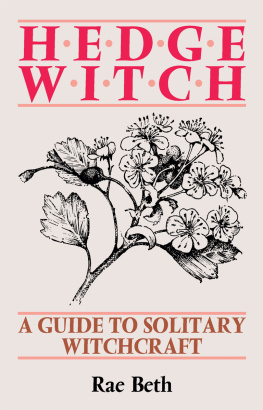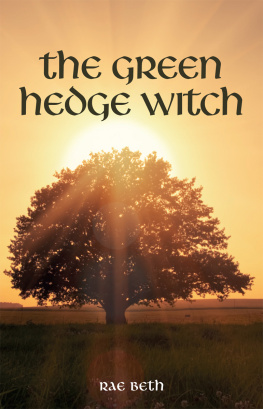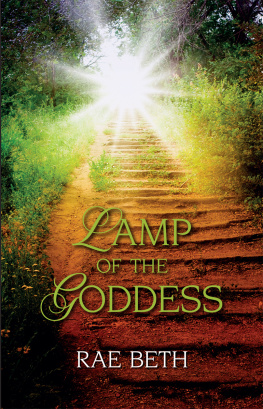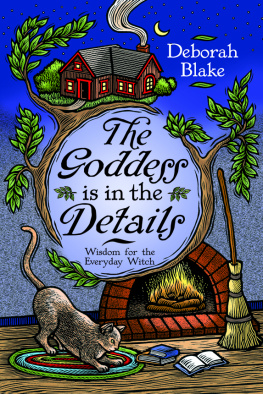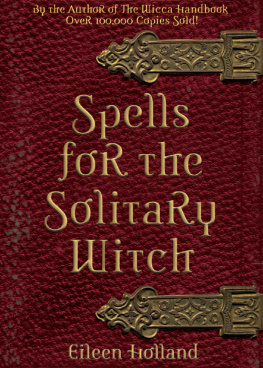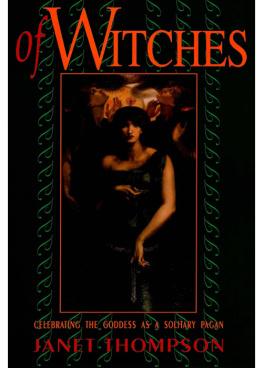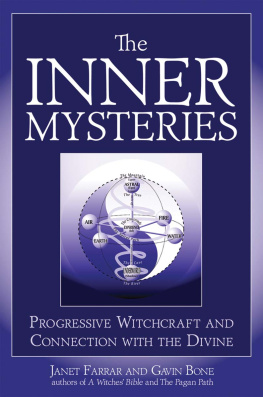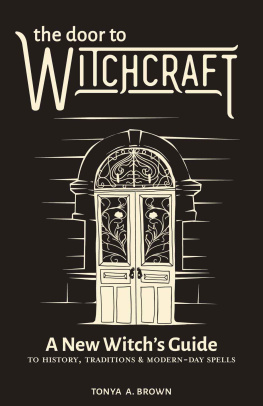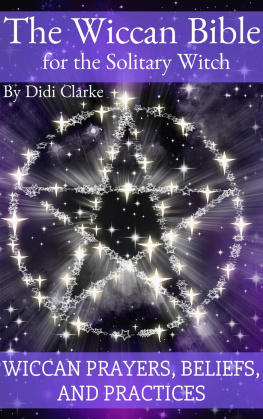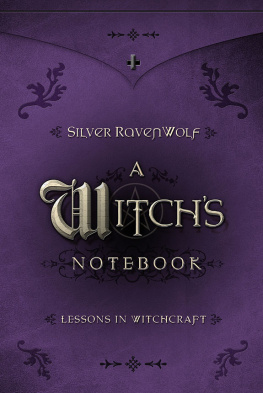Hedge Witch
A Guide to Solitary Witchcraft
RAE BETH

ROBERT HALE
First published in 1990 by Robert Hale, an imprint of
The Crowood Press Ltd, Ramsbury,
Marlborough Wiltshire SN8 2HR
www.crowood.com
This e-book first published in 2017
Rae Beth 1990
All rights reserved. This e-book is copyright material and must not be copied, reproduced, transferred, distributed, leased, licensed or publicly performed or used in any way except as specifically permitted in writing by the publishers, as allowed under the terms and conditions under which it was purchased or as strictly permitted by applicable copyright law. Any unauthorised distribution or use of thistext may be a direct infringement of the authors and publishers rights, and those responsible may be liable in law accordingly.
British Library Cataloguing-in-Publication Data
A catalogue record for this book is available from the British Library.
ISBN 978 0 71982 686 3
The right of Rae Beth to be identified as author of this work has been asserted by her in accordance with the Copyright, Designs and Patents Act 1988.
Hedge Witch
Rae Beth has been studying Pagan traditions and womens mysteries for many years. Her interest grew when her involvement with the womens movement and her work as an astrologer and tarot consultant converged in Goddess spirituality. She became a self-initiated witch in 1978, perceiving the role of witch as a poetic symbol of womens psychic strength, as well as a key to the resurgence of Pagan ideals, such as a reverence for the Earth. Later, she also came to understand the role of the male witch, as present-day shaman and brother to the wisewoman or witch priestess.
Born a schoolteachers daughter, she was once a student teacher herself, specializing in English literature. She now writes magical poetry. An active environmentalist, Rae Beth lives just outside Bath, where she enjoys country walks, and is married with two children.
Introduction
The following letters were not meant to be in a book, originally. They were written as lessons for two apprentice witches. For the real-life Tessa and Glyn. Then I realized that this could well be a book of interest to many who are seeking a path of nature magic, but who are unprepared, for one reason or another, to involve themselves with covens.
Tessa and Glyn have been taught in an old tradition, that of the solitary or hedge witch. This is rather like the old-time village wisewoman or wiseman: one who knows and worships the Goddess and her consort, the Horned God; one who practises spellcraft for the purposes of healing, and teaches the mysteries. Though this is sometimes a lonely path, it leads to places of great beauty. Parts of it can be walked in company with others, but the magical workings are always done alone, or with one magical partner. This suits some of us, for there is a certain kind of witch at home with solitude. He or she need not be friendless. But by temperament, some are drawn to worship and work magic on their own, and to fulfil a different archetype from that of coven member. To them, and to my husband and magical partner Cole Campion, this book is dedicated.
Rae Beth
Yule 1988
The West of England
New Green
Avonford
8th January 1987
Dear Tessa and Glyn,
I will answer your question, What is witchcraft? in letter form. And I will start with the most surprising things I can think of. The biggest surprise to most people about witches, once they have realized we are not devil-worshippers nor tools of the powers of evil (in true horror-movie style), is that we worship a female deity, a Goddess. We also worship a God. That does not really surprise anyone. But reverence for the Mother of All Life, in this culture, is unexpected. It has implications, spiritually, emotionally and socially.
Historically, witches have been persecuted for their belief in a Goddess. It was politically unacceptable in a patriarchal culture. Worship of a Goddess would have to mean, for example, that the earth, Mother Earth, would once again be held sacred. She could no longer be polluted or exploited for any reason, and a great deal of power and profit would be lost by unscrupulous men. Better, from their point of view, to worship a God who is all mind and spirit, out there up in heaven, away from the disgusting, sinful Earth.
In the spiritual view of our modern world, femaleness has long been reckoned as not quite so holy as maleness. Woman, in all the worlds patriarchal religions - Christianity and Islam in particular - is seen as the bringer of sin, a snare and a trap for the holier sex. Closer to animality, through menstruation and childbirth, and to the earth. How can there be a God who is female? most people would now ask. Witches would answer that childbearing is the original creative act, and that prehistoric people worshipped both gods and goddesses (primarily goddesses) since time out of mind. This is shown by the earliest mythologies, and by the numerous pictures and statues of goddesses which have been found at ancient sites all over the world.
Nowadays, some witches, in rebellion against the cruel suppression of Goddess worship, would actually go so far as to say that only the Goddess should be worshipped. An understandable but sad reaction. However, the Father of All Life, the God, must be acknowledged too. He exists and his suppression would be as destructive as the suppression of all knowledge of the Mother Goddess. The true aim of witchcraft is reconciliation of opposites. Bitterness, hatred and resentment between the sexes is as old as history, but witchcraft is the only religion which has as its avowed aim the healing of these wounds. Sadly, there are those in the world, of both sexes, who have no desire for reconciliation or perhaps no belief that such a thing is possible. To them, for them, I cannot speak. But I can speak to you two and perhaps to others. What I am saying is that witchcraft, at least potentially, is a religion of healing.
Where does it gain its credentials? What is its history? Witchcraft is Paganism. More specifically, it is a type of Paganism with roots in our neolithic past. It has evolved and endured through thousands of years of persecution. In the present day, it is a system of beliefs and magical practices dedicated to restoring the lost harmony between humanity and the subtle, transrational aspects of life, the mysteries. Our belief is that this would restore, also, the lost harmony between humanity and Mother Earth. Though it is now new, reborn, it was, in fact, a form of the Old Religion. Perhaps, now, you can see why it has been dubbed as evil. For such slander is the standard practice of an incoming religion displacing an old one. Witches, then, are not necessarily evil. They are simply followers of a religion which predated Christianity.
Second surprising fact: witches are not always elderly women, although they can be. In any case, they are no more prone to warts than the average member of the population (though considerably better at charming warts away). They are not recognizable. Not only do they not wear tall black hats, but they could be of any age and either sex. (The men are called witches, too; not warlocks, as some people think.) Some work in covens, some alone and some, like myself, with one magical partner. But you have no way of knowing who among your neighbours might be one. It could be anybody.
Yes, they do practise magic. Not to curse or to undermine but to help and heal. Does it work? Does magic achieve anything? Third surprising fact: yes. But it has to be learned, like anything else.
Also, yes, witches do sometimes work naked in their rites. Even solitary witches do this, for we believe in the sacredness of all our bodies and we enjoy the freedom and beauty of going skyclad. Furthermore, tradition says that magic can be worked more effectively like this, as clothes can impede the flow of the witchs etheric energy. It is for warm weather, of course, or by a blazing fire. There is nothing magically effective about gooseflesh!
Next page
